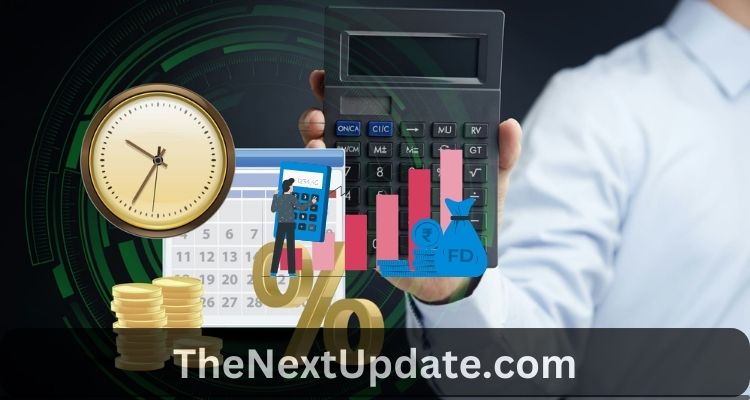Fixed Deposits (FDs) are investments offered by banks and Non-Banking Financial Companies (NBFCs) that typically provide higher interest rates than regular savings accounts. However, they come with specific regulations. When you invest in these deposits, your money is held for a specific period, which can range from as little as 7 days to as long as 10 years. To calculate the interest earned and the total amount at maturity, an FD interest rate calculator comes in handy. It assists in determining the potential interest your deposit might get and the final sum you’ll receive when it reaches its maturity.
Using an Online FD Calculator: Step by Step
FDs offer a secure investment avenue that offer promising returns. Utilising an online FD calculator is a smart way to predict your potential earnings and plan your investments effectively. Follow these steps to make the most of this financial tool:
Step 1: Customer Type
This step involves selecting your customer status, which could be either “Normal” or “Senior Citizen.” Your choice here helps determine the interest rates applicable to your deposit.
Step 2: FD Type
You’ll have various options to choose from based on how you want to manage your FD:
- Cumulative FD: Interest is compounded over the deposit period, and you receive the entire maturity amount at the end.
- Interest Payout (Quarterly/Monthly): You receive periodic interest payouts (monthly or quarterly) while the principal remains invested.
- Based on tenure: This option is for those interested in shorter-term investments with different interest rates or terms.
Step 3: FD Start Date
In this step, you must set your FD start date according to your choice. Typically, the calculator sets the starting date as today’s date by default. This is the date from which your FD tenure will begin.
- Enter FD Amount: Input the specific amount you wish to deposit into the FD. This amount will determine the interest accrued and the final maturity amount.
Step 4: Tenure Format
This step allows you to choose how you’d like to specify the duration of your FD. You have two options:
- Combination of Years/Months/Days: Here, you can enter the tenure using a mix of years, months, and days. For instance, you might choose to invest for 2 years and 6 months.
- Total Number of Days: Alternatively, you can input the total duration of your FD in days. This could be a simpler approach if you want precise control over the days your money remains invested.
- Input Tenure: Based on the format you’ve selected previously, enter the specific duration for which you want to invest your money.
For instance:
- If you’ve chosen the combination format, input the number of years, months, and days accordingly.
- If you’ve opted for the total number of days, directly enter the total duration in days.
After providing these details, the FD Calculator processes the information and displays various important outcomes:
- Applicable Interest Rate: This is the interest rate at which your FD will grow over the chosen tenure.
- Interest Amount: The calculator will show you how much interest you’ll earn based on the deposited amount and tenure.
- Maturity Date: It specifies when your FD will mature, indicating the date when you can withdraw the total amount.
- Maturity Amount: This is the total amount you’ll receive at maturity, including both the principal and the accumulated interest.
Understanding these results is essential as they provide insights into the interest earnings and the final amount you’ll receive at the end of the FD tenure.
FD Calculations for Resident and NRI Customers
FD Calculations for Resident Customers:
Applicable Deposits and Tenure:
- Deposit amount: Rs 10,000 to Rs 1,99,99,999.
- Various payout types with specific tenure ranges:
- Cumulative interest payout: 6 months to 10 years.
- Quarterly interest payout: 3 months to 10 years.
- FD calculator monthly interest payout: 7 days to 10 years.
- Short-term FD: 7 days to 91 days.
Interest Rates and TDS:
- Default interest rates for deposits less than Rs 1 crore.
- TDS is applicable to the interest earned based on prevailing rates.
Calculator Usage:
- Helps determine maturity amount based on deposit amount, tenure, and FD type.
- Interest calculation based on specified rates for chosen tenure and deposit type.
- FD Calculation for NRI Customers:
Applicable Deposits:
- Covers deposits up to Rs 1,99,99,999 (for rates on deposits of Rs 2 crore and above, refer to the specified section).
- Senior citizen rates do not apply to Non-Resident External (NRE) and Non-Resident Ordinary (NRO) Deposits.
Maturity and Tenure:
- NRE FD tenure: 1 year to 10 years.
- NRO FD tenure: 7 days to 10 years.
Interest Rates and TDS:
- Maturity amount for NRO FDs, subject to applicable TDS.
- Interest rates are subject to periodic changes; refer to the latest rates for accuracy.
Minimum Deposit Amount:
- The minimum amount for an FD is Rs 25,000 for NRIs.
Resident and NRI FDs have specific parameters governing their deposit amounts, tenure, interest rates, and taxation implications. It’s crucial to consider these factors while using the FD calculator to compute maturity amounts accurately. Additionally, staying updated with the latest interest rates is advisable for precise calculations and informed investment decisions.
Tips for Planning Your Investments Effectively
- Know Your Current Financial Situation: Before investing, understand your income, expenses, and savings. Create a budget to assess how much you can comfortably invest without impacting your essentials or emergency funds.
- Define Clear Financial Goals: Determine why you’re investing. Whether it’s for short-term goals like a vacation or long-term objectives such as retirement, having specific goals helps shape your investment strategy.
- Consider Risk and Time Horizon: Assess your risk tolerance based on your age, financial responsibilities, and investment goals. Younger individuals might take more risk for potentially higher returns, while those closer to retirement may opt for safer investments.
- Diversification is Key: Spread your investments across different asset classes like stocks, bonds, real estate, and other options to reduce risk.
- Regularly Monitor and Rebalance: Review your investments periodically. Ensure they align with your goals and risk tolerance. Rebalance your portfolio as needed to maintain your desired asset allocation.
- Educate Yourself: Learning about various investment options, market trends, and financial instruments will help you make informed decisions.
- Consider Professional Advice: If needed, seek guidance from a financial advisor. They can help make an investment plan according to your needs and circumstances.
- Start Early, Stay Consistent: The earlier you start investing, the more time your money has to grow. Consistent, disciplined investing can lead to significant growth over time, even with smaller amounts.
- Emergency Fund First: Prioritise creating an emergency fund before making substantial investments. This safety net ensures you’re financially secure in unexpected situations.
- Review Tax Implications: Understand the tax implications of your investments. Certain accounts or investments might offer tax advantages that can impact your overall returns.
Conclusion
Investing in FDs offers a secure financial decision that promises stable returns. Utilising an online FD interest rate calculator is another step toward making investment decisions. Individuals can accurately predict their potential earnings and final maturity amounts by following a systematic process involving selecting customer types, choosing FD types, setting start dates, and specifying amounts and tenures.




